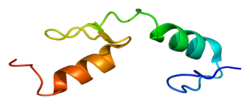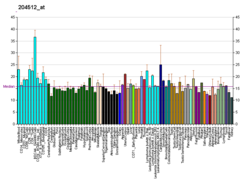| HIVEP1 |
|---|
 |
| Estruturas disponíveis |
|---|
| PDB | Pesquisa Human UniProt: PDBe RCSB |
|---|
| Lista de códigos id do PDB |
|---|
1BBO, 4ZNF |
|
|
| Identificadores |
|---|
| Nomes alternativos | HIVEP1, proteína de dedo de zinco 40 |
|---|
| IDs externos | OMIM: 194540 HomoloGene: 1596 GeneCards: HIVEP1 |
|---|
|
| Doenças Geneticamente Relacionadas |
|---|
| toxicomania[1] |
| Ontologia genética |
|---|
| Função molecular | • GO:0000980 RNA polymerase II cis-regulatory region sequence-specific DNA binding
• DNA binding
• sequence-specific DNA binding
• GO:0001078, GO:0001214, GO:0001206 DNA-binding transcription repressor activity, RNA polymerase II-specific
• GO:0001948, GO:0016582 ligação a proteínas plasmáticas
• metal ion binding
• nucleic acid binding
• GO:0001200, GO:0001133, GO:0001201 DNA-binding transcription factor activity, RNA polymerase II-specific
|
|---|
| Componente celular | • citoplasma
• mitocôndria
• núcleo celular
• cariolinfa
• nuclear body
|
|---|
| Processo biológico | • multicellular organism development
• GO:0009373 regulation of transcription, DNA-templated
• GO:1901227 negative regulation of transcription by RNA polymerase II
• transcription by RNA polymerase II
• GO:0072468 transdução de sinal
• transcription, DNA-templated
• BMP signaling pathway
• GO:0003257, GO:0010735, GO:1901228, GO:1900622, GO:1904488 positive regulation of transcription by RNA polymerase II
|
|---|
| Sources:Amigo / QuickGO |
|
|
| Ortólogos |
|---|
| Espécie | Humano | Rato |
|---|
| Entrez | | |
|---|
| Ensembl | | |
|---|
| UniProt | | |
|---|
| RefSeq (mRNA) | | |
|---|
| RefSeq (proteína) | | |
|---|
| Localização (UCSC) | n/a | n/a |
|---|
| Pesquisa PubMed | [2] | n/a |
|---|
|
| Wikidata |
|
A proteína de dedo de zinco 40 é uma proteína que em humanos é codificada pelo gene HIVEP1.[3][4][5]
Função
Membros da família ZAS, como ZAS1 (HIVEP1), são proteínas grandes que contêm um domínio ZAS, uma estrutura proteica modular que consiste em um par de dedos de zinco C2H2 com uma região rica em ácido e uma sequência rica em serina/treonina. Essas proteínas se ligam a sequências específicas de DNA, incluindo o motivo kappa-B (GGGACTTTCC), nos promotores e regiões potenciadoras de vários genes e vírus, incluindo o vírus da imunodeficiência humana (HIV). Os genes ZAS abrangem mais de 150 kb e contêm pelo menos 10 éxons, um dos quais é maior que 5,5 kb.[6]
Referências
- ↑ «Doenças geneticamente associadas a HIVEP1 ver/editar referências no wikidata»
- ↑ «Human PubMed Reference:»
- ↑ «Entrez Gene: HIVEP2 human immunodeficiency virus type I enhancer binding protein 2»
- ↑ Gaynor, Richard B.; Muchardt, Christian; Diep, Ahn; Mohandas, T. K.; Sparkes, Robert S.; Lusis, Aldons J. (1 de abril de 1991). «Localization of the zinc finger DNA-binding protein HIV-EP1/MBP-1/PRDII-BF1 to human chromosome 6p22.3–p24». Genomics (em inglês) (4): 758–761. ISSN 0888-7543. doi:10.1016/0888-7543(91)90371-K. Consultado em 1 de março de 2022
- ↑ «HIVEP1 HIVEP zinc finger 1 [Homo sapiens (human)] - Gene - NCBI». www.ncbi.nlm.nih.gov. Consultado em 1 de março de 2022
- ↑ «Entrez Gene: HIVEP1 human immunodeficiency virus type I enhancer binding protein 1»
Leitura adicional
- Nomura N, Nagase T, Miyajima N, Sazuka T, Tanaka A, Sato S, Seki N, Kawarabayasi Y, Ishikawa K, Tabata S (1995). «Prediction of the coding sequences of unidentified human genes. II. The coding sequences of 40 new genes (KIAA0041-KIAA0080) deduced by analysis of cDNA clones from human cell line KG-1». DNA Research. 1 (5): 223–9. PMID 7584044. doi:10.1093/dnares/1.5.223
- Wu CL, Zukerberg LR, Ngwu C, Harlow E, Lees JA (maio de 1995). «In vivo association of E2F and DP family proteins». Molecular and Cellular Biology. 15 (5): 2536–46. PMC 230484
 . PMID 7739537. doi:10.1128/mcb.15.5.2536
. PMID 7739537. doi:10.1128/mcb.15.5.2536 - Karlseder J, Rotheneder H, Wintersberger E (abril de 1996). «Interaction of Sp1 with the growth- and cell cycle-regulated transcription factor E2F». Molecular and Cellular Biology. 16 (4): 1659–67. PMC 231152
 . PMID 8657141. doi:10.1128/mcb.16.4.1659
. PMID 8657141. doi:10.1128/mcb.16.4.1659 - Rogers KT, Higgins PD, Milla MM, Phillips RS, Horowitz JM (julho de 1996). «DP-2, a heterodimeric partner of E2F: identification and characterization of DP-2 proteins expressed in vivo». Proceedings of the National Academy of Sciences of the United States of America. 93 (15): 7594–9. PMC 38791
 . PMID 8755520. doi:10.1073/pnas.93.15.7594
. PMID 8755520. doi:10.1073/pnas.93.15.7594 - Magae J, Wu CL, Illenye S, Harlow E, Heintz NH (julho de 1996). «Nuclear localization of DP and E2F transcription factors by heterodimeric partners and retinoblastoma protein family members». Journal of Cell Science. 109 (7): 1717–26. PMID 8832394
- Hofmann F, Livingston DM (abril de 1996). «Differential effects of cdk2 and cdk3 on the control of pRb and E2F function during G1 exit». Genes & Development. 10 (7): 851–61. PMID 8846921. doi:10.1101/gad.10.7.851
- Lindeman GJ, Gaubatz S, Livingston DM, Ginsberg D (maio de 1997). «The subcellular localization of E2F-4 is cell-cycle dependent». Proceedings of the National Academy of Sciences of the United States of America. 94 (10): 5095–100. PMC 24637
 . PMID 9144196. doi:10.1073/pnas.94.10.5095
. PMID 9144196. doi:10.1073/pnas.94.10.5095 - Dynlacht BD, Moberg K, Lees JA, Harlow E, Zhu L (julho de 1997). «Specific regulation of E2F family members by cyclin-dependent kinases». Molecular and Cellular Biology. 17 (7): 3867–75. PMC 232239
 . PMID 9199321. doi:10.1128/mcb.17.7.3867
. PMID 9199321. doi:10.1128/mcb.17.7.3867 - Pierce AM, Schneider-Broussard R, Philhower JL, Johnson DG (julho de 1998). «Differential activities of E2F family members: unique functions in regulating transcription». Molecular Carcinogenesis. 22 (3): 190–8. PMID 9688145. doi:10.1002/(SICI)1098-2744(199807)22:3<190::AID-MC7>3.0.CO;2-P
- Humbert PO, Verona R, Trimarchi JM, Rogers C, Dandapani S, Lees JA (março de 2000). «E2f3 is critical for normal cellular proliferation». Genes & Development. 14 (6): 690–703. PMC 316459
 . PMID 10733529
. PMID 10733529 - Takahashi Y, Rayman JB, Dynlacht BD (abril de 2000). «Analysis of promoter binding by the E2F and pRB families in vivo: distinct E2F proteins mediate activation and repression». Genes & Development. 14 (7): 804–16. PMC 316494
 . PMID 10766737. doi:10.1101/gad.14.7.804 (inativo 17 de fevereiro de 2019)
. PMID 10766737. doi:10.1101/gad.14.7.804 (inativo 17 de fevereiro de 2019) - Leone G, Nuckolls F, Ishida S, Adams M, Sears R, Jakoi L, Miron A, Nevins JR (maio de 2000). «Identification of a novel E2F3 product suggests a mechanism for determining specificity of repression by Rb proteins». Molecular and Cellular Biology. 20 (10): 3626–32. PMC 85655
 . PMID 10779352. doi:10.1128/MCB.20.10.3626-3632.2000
. PMID 10779352. doi:10.1128/MCB.20.10.3626-3632.2000 - He Y, Armanious MK, Thomas MJ, Cress WD (julho de 2000). «Identification of E2F-3B, an alternative form of E2F-3 lacking a conserved N-terminal region». Oncogene. 19 (30): 3422–33. PMID 10918599. doi:10.1038/sj.onc.1203682
- Yamochi T, Semba K, Tsuji K, Mizumoto K, Sato H, Matsuura Y, Nishimoto I, Matsuoka M (dezembro de 2001). «ik3-1/Cables is a substrate for cyclin-dependent kinase 3 (cdk 3)». European Journal of Biochemistry / FEBS. 268 (23): 6076–82. PMID 11733001. doi:10.1046/j.0014-2956.2001.02555.x
- Weinmann AS, Yan PS, Oberley MJ, Huang TH, Farnham PJ (janeiro de 2002). «Isolating human transcription factor targets by coupling chromatin immunoprecipitation and CpG island microarray analysis». Genes & Development. 16 (2): 235–44. PMC 155318
 . PMID 11799066. doi:10.1101/gad.943102
. PMID 11799066. doi:10.1101/gad.943102 - Ren B, Cam H, Takahashi Y, Volkert T, Terragni J, Young RA, Dynlacht BD (janeiro de 2002). «E2F integrates cell cycle progression with DNA repair, replication, and G(2)/M checkpoints». Genes & Development. 16 (2): 245–56. PMC 155321
 . PMID 11799067. doi:10.1101/gad.949802
. PMID 11799067. doi:10.1101/gad.949802 - He Y, Cress WD (junho de 2002). «E2F-3B is a physiological target of cyclin A». The Journal of Biological Chemistry. 277 (26): 23493–9. PMID 11980909. doi:10.1074/jbc.M202629200
- Schlisio S, Halperin T, Vidal M, Nevins JR (novembro de 2002). «Interaction of YY1 with E2Fs, mediated by RYBP, provides a mechanism for specificity of E2F function». The EMBO Journal. 21 (21): 5775–86. PMC 131074
 . PMID 12411495. doi:10.1093/emboj/cdf577
. PMID 12411495. doi:10.1093/emboj/cdf577
 | Este artigo sobre Genética é um esboço. Você pode ajudar a Wikipédia expandindo-o. |
 Portal da genética
Portal da genética

 . PMID 7739537. doi:10.1128/mcb.15.5.2536
. PMID 7739537. doi:10.1128/mcb.15.5.2536  . PMID 8657141. doi:10.1128/mcb.16.4.1659
. PMID 8657141. doi:10.1128/mcb.16.4.1659  . PMID 8755520. doi:10.1073/pnas.93.15.7594
. PMID 8755520. doi:10.1073/pnas.93.15.7594  . PMID 9144196. doi:10.1073/pnas.94.10.5095
. PMID 9144196. doi:10.1073/pnas.94.10.5095  . PMID 9199321. doi:10.1128/mcb.17.7.3867
. PMID 9199321. doi:10.1128/mcb.17.7.3867  . PMID 10733529
. PMID 10733529  . PMID 10766737. doi:10.1101/gad.14.7.804 (inativo 17 de fevereiro de 2019)
. PMID 10766737. doi:10.1101/gad.14.7.804 (inativo 17 de fevereiro de 2019)  . PMID 10779352. doi:10.1128/MCB.20.10.3626-3632.2000
. PMID 10779352. doi:10.1128/MCB.20.10.3626-3632.2000  . PMID 11799066. doi:10.1101/gad.943102
. PMID 11799066. doi:10.1101/gad.943102  . PMID 11799067. doi:10.1101/gad.949802
. PMID 11799067. doi:10.1101/gad.949802  . PMID 12411495. doi:10.1093/emboj/cdf577
. PMID 12411495. doi:10.1093/emboj/cdf577 
 Portal da genética
Portal da genética













